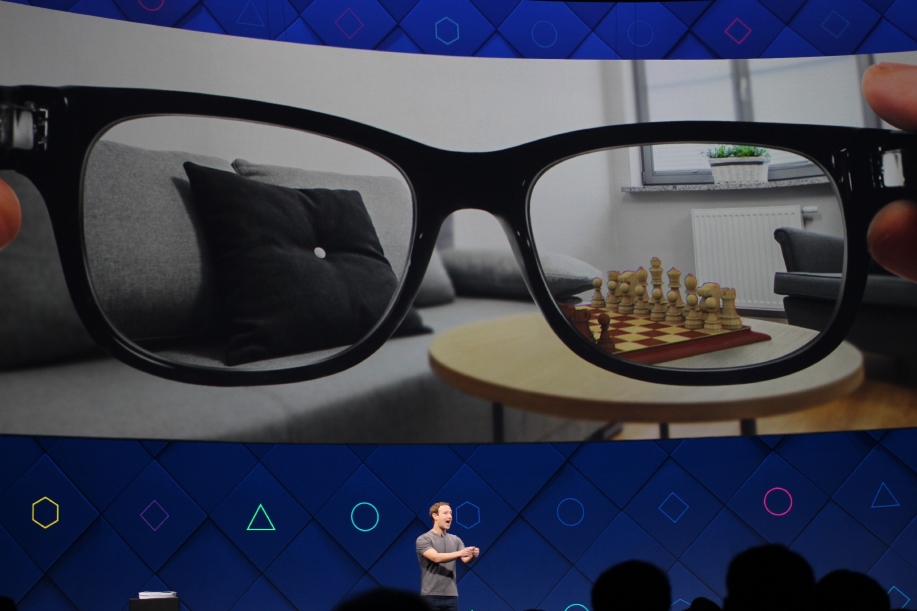Challenged by its rivals, Google and Apple, Facebook has submitted a patent for a pair of AR (Augmented Reality) glasses capable of displaying virtual objects on a real background.
Media and AR Technology
Technology is increasingly entering into the mainstream media entertainment and Facebook as well is on several projects. It’s been a while since we have heard that Menlo Park is interested in augmented reality, but now it is no longer a mere indiscretion.
Mark Zuckerberg’s social networking company, Oculus, has recently filed a patent which describes the development plans for a pair of AR glasses with a display that uses a two-dimensional scanner instead of normal lenses. For now, it is only a patent, and there’s still nothing precise about its launch on the market, but it’s fair to think that in a couple of years Facebook could bring on the market a new pair of glasses capable of simulating augmented reality through its lenses.
Also, other tech giants, including Apple and Google, are focusing on AR (Augmented Reality) technology. Google Glass, released in 2013, was a first attempt to make this technology dominant. Even though many thought that Google Glass had been dismantled, it has recently been reused as a tool for business. Apple too is working on AR technology for its iPhone and iPad through the development of the ARKit platform. Insistent rumors say that Apple Glasses will be released by 2019.
Facebook AR Glasses
This technology was developed by Oculus, a company acquired by Facebook in 2014 for $ 2 billion. Oculus was already famous for its Rift viewer, a helmet that lets you enter a virtual reality world. Unlike the latter, AR glasses allow users to see and interact with virtual objects overlapped in the real world.
More details are emerging in these hours on the AR device that Facebook is planning to develop. Oculus has said that its smartglasses can project the light in front of the users’ eyes in a different way from other screens, through a particular technology called “waveguide display”, i.e. a waveguide with a two-dimensional scanner that can add images and videos to the users’ views.
Facebook’s AR device can process virtual video, will be equipped with a speaker and, for a more immersive experience, it will work alongside with your headphones and consoles.
On the logo of the patent, which is available on the US Patent Office website, there is a pair of standard glasses. Even though they look like standard glasses, these glasses can be modified to suit the tastes and trends of the time. They will be probably launched onto the market equipped with a transparent screen that allows observing the reality outside and two side frames that will house the sensors, the processor, and the battery.
AR and virtual reality
The American colossus is, therefore, going to match virtual reality with AR. To make it clear, the latter overlaps the real world with computer-generated contents, such as sounds, video, graphics, or GPS data. An example of this is Snapchat. This app uses filters, called “Lenses” that can add masks, drawings and other elements to the user’s pictures.
On the contrary, virtual reality is completely artificial. Computer-generated simulation captures the user, making him feel as if he were personally experiencing a virtual reality.
Facebook’s patented glasses could compete with Microsoft’s Hololens, the $ 3,000 futuristic viewer that, through a transparent screen, lets you see virtual objects and people on a real background. Hololens’ new generation will jointly develop virtual reality and AR through the new Al Co-CPU.
Similarly to Hololens, Facebook Glasses will not block the sunlight, but will allow you to add new virtual elements to the real background.
Pasi Saarikko, who is now at the head of the Oculus Team, was one of the engineers who participated to the invention of the first generation of AR glasses by Microsoft. He will now put his experience at the service of Mark Zuckerberg’s futuristic projects.
AR application areas
Many are the areas where AR is applied. Thanks to a simple fashionable accessory that everyone can wear, like a pair of glasses, for example, you can search for pictures just by framing a statue, a painting, a hotel, and so on.
Facebook’s AR glasses will not only have to deal with Microsoft Hololens but also with Snapchat Spectacles, which let you share moments of your own real life by transforming them into 30-second videos to spin on Snapchat app itself.
Facebook is determined to become a major actor in the sphere of virtual reality. The company has recently launched Spaces, the first virtual social network within the Oculus Rift viewer. On the Spaces app, users can interact with other users or post live photos or videos on their Facebook profiles.
The Menlo Park’s company has described Spaces as a new reality-enhanced app that lets you spend time with your friends in an interactive, entertaining virtual environment as if you were in the same room.
A future through the lenses
Oculus team is ambitious and expects, by 2022, a significant increase in the popularity of AR smartglasses.
Piper Jaffray’s analyst, Gene Munster, has even predicted that smartglasses will definitely replace smartphones in a not too far away future. It is the same opinion that Michael Abrash, Oculus chief scientist, has. As a matter of fact, at the latest Facebook Developer Conference, he said that within 20-30 years, people will replace smartphones with AR and virtual reality glasses.
Facebook executives and other tech colossus seem to agree, given the efforts and investments that are deepening in this field. So is there a future for us “through the lenses”? The potentiality is there, but we will have to wait for a while before getting some results.

